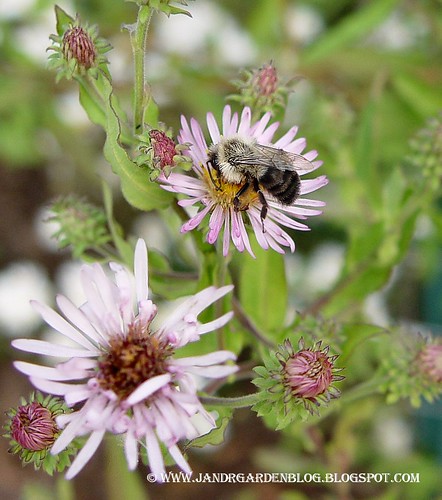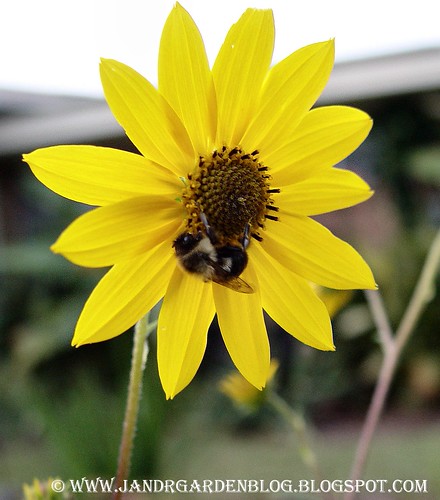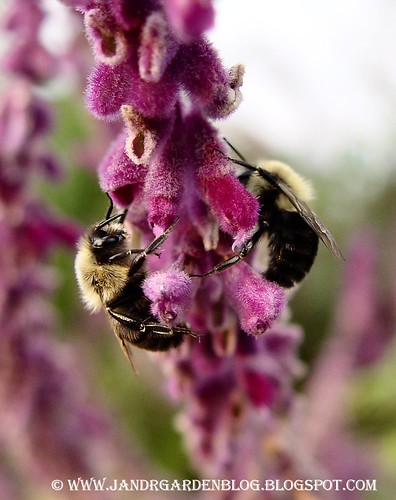As I walk through the garden in the late evening taking pictures, I notice all the insects settling in for the night. The butterflies hang from protected spots in trees and shrubs and the bees curl up comfortably on flowers. I have just recently begun to notice, the instant the sun disappears over the horizon; the bees are ready for a rest. They curl their little antlers up, tuck their chins to their chests and off to sleep they go.
Late every afternoon I stroll around the garden to watch them nestle into beds of asters, sunflowers and sage blooms. I was thinking to myself; now that’s the life, fly around all day drinking sweet nectar and passing out exhausted on a flower. After the initial enthusiasm and amazement of my new discovery began to subside, I started to wonder why they do this. So, I set out to find the answer to my question. On my little research journey, I discovered bees are amazing creatures.
To answer the original question, they sleep on the flowers because they have no where else to rest. They are little boy bees that have been cast out from their homes. This is the story of how they came to live as they do. BEE fore warned this story does not have a fairytale ending.
In the very first days of spring, when all the flowers begin to bloom, the queen bees make their appearance. They are the large bees you see slowly flying around during the first warm days of the growing season. They are searching for the perfect place to build a palace. When she finds an area suited to her needs she gathers pollen to make a soft place to lay about eight eggs. After the eggs are laid, she will cover them with a thin layer of wax secreted from the gland on her sternum. Then, she will rest on them just like a chicken and raise her body temperature to a range between 98 and 102 degrees Fahrenheit. From this point forward, she will only leave the nest for periods of 30 minutes or less to gather pollen and nectar for nutrition. After about 20 days, the first brood of workers will be born and the queen commits the remainder of her life to laying eggs, leaving the nest building and daycare to the workers.
Bumblebees are very much unorganized nest builders compared to honey bees, but they are extremely efficient when it comes to recycling materials. The nest of a bumblebee rarely gets larger than half the size of a baseball. As the brood cells are emptied they become storage areas for nectar and pollen. As new workers emerge from the cells, house keeping workers will take the removed cell caps and use them to enclose other eggs. They waste very little materials when building the nest. As the larvae grow, the nursery workers feed them a combination of pollen and nectar that has been kneaded into a substance referred to as Bee Bread.
During the nest building process, the queen only lays eggs that will produce worker bees, all of which are female. 66% of these workers will remain at the nest constructing cells and caring for the young and the remaining 34% will gather food. You can recognize the workers that leave the nest by the large pouches of pollen on their hind legs. When she is satisfied with the size of the home her workers have made, she will begin laying the eggs for drones and queens. The queen determines what the eggs will be before she lays them. The female worker bees, which are born from fertilized eggs, do not have the hormones to produce ovaries. As a result, about mid summer the queen begins producing fertilized eggs with the necessary hormones to become queens and unfertilized eggs that will become the drone class of bees consisting entirely of males.
When the queens and drones are born, the queens are allowed to stay until they choose to leave, but the drones are forced to leave and never return again. The male bees are sent out into the world to feed on nectar and sleep on flowers until they meet their tragic end. The drones are the smallest of bumblebees and have no stingers, so they are completely harmless. Another interesting fact I learned concerning bumblebees is the buzzing that you hear is not coming from their wings. The buzz is actually the sound of them vibrating their bodies to shake the pollen off their antlers and out of their body fuzz. You primarily hear this noise from drones because they have no use for pollen.
So, the little bees we see sleeping on flowers are the homeless males whose sole purpose is to fertilize the new queens when they decide to leave the nest. This is where the poor male will meet his end. The breeding process between a drone and queen lasts about 30 minutes. When the queen has decided the mating is complete, she rips away from the drone tearing him so severely he is left to die. Poor thing, he is thrown out of his home at birth and when something good finally happens, it kills him. The young queen will repeat this process with several drones, storing up sperm in a special internal container called a spematheca. In the late fall she burrows under ground to hibernate until the spring.
The old queen, workers and remaining drones will perish with the first frost. The nest is now abandoned and will deteriorate over time. I learned so much more that I would love to share with you, but it’s simply too much information. But, if you have ever wondered why the little bees sleep on flowers you now have the answer.





12 comments:
Hi J and R, such a sad sad tale about our friends the bees. We have them hanging around all over, but since we had a killing frost last night they might be gone. At least they died in their sleep instead of being ripped apart! I did have to laugh out loud at your statement that when finally something good happens in their lives they are kill right after. ;-> I know that's is not very nice to laugh about, forgive me.
Frances
http://fairegarden.wordpress.com/
ps I will send you an email when I ship the grass so you can be looking for it.
F
Well, Frances, It's such a traumatic end, I had to inject some humor in there somewhere. Passing away while sleeping is definitely a better way to go.:-) -Randy
Life is nasty, brutish, and short in the insect world, isn't it? Interesting factoids about bees, and lovely pics too.
I'd never have thought to investigate this on my own ... thank you for an entertaining and informative lesson!
Pam,
Thanks for the compliments on the Pictures. Yes, they have short lives, but I guess for the most part they are stress free. That’s at least one thing they have going for them. :-)
Cindy,
I’m a very inquisitive person and I LOVE useless and interesting facts. My head is filled with them. LOL If I find myself interested in something I’ll research it over and over again until I’m satisfied I know as much as I want to learn about it. Too bad I haven’t figured a way to turn that into a money making venture.
What an interesting lesson on the bees. I didn't realize these poor things were cast off into the cold cruel world.
Hey PG,
Thanks for the visit. The good thing about it is they don't have to spend their entire lives in the nest. They get to experience the flowers. :-)
I knew some of the facts of your posting, but not the one about males being homeless. I, too, have seen several bees sleeping among the flowers but thought that bumblebees were solitary bees and didn't make nests. See, it is good to learn something new every day. Thanks for the info.
Jan
Always Growing
Well Jan,
They don't have it toooooo bad. Wouldn't you love to sleep on a flower? :-)-Randy
Love your posts!
Hi....I loved this post. The solitary bees intrigue me...they are hard workers, too. Your photos are delightful!
gail
Thank you Gail. :-) This was a fun post to write.
Post a Comment